There are many more kalanchoe varieties than the commonly seen types found in nurseries and floral shops. Those kalanchoe plant varieties (Kalanchoe blossfeldiana) have softly scalloped leaves and produce a stalk adorned with bright, starry flowers. But not all varieties of kalanchoe are grown for their flowers.
Several kalanchoe plant types have lovely unique foliage that is just as appealing and worthy of interest. There are over 100 species of kalanchoe native to Madagascar alone, which means there is a variety for every taste. So if you fancy growing kalanchoes, you might be a little overwhelmed by the choice. Read on to discover some of the most intriguing and easy-to-grow kalanchoes.
8 Easygoing Kalanchoe Varieties to Try
The most common kalanchoe plant varieties are cultivars of K. blossfeldiana. Its little flowers come in magenta, yellow, pink, orange and red. Flowers last for months in late winter and if you want to make a kalanchoe rebloom, these do so easily. Even when not in bloom, its glossy, fleshy leaves are attractive. The plant needs slightly cooler temperatures at night than in the day to promote flowering. Bright light, well-draining soil and light water needs characterize these types of kalanchoe plants.
However, there are many more kalanchoe varieties to consider, with plenty of variety in foliage, ranging from succulent style leaves to noticeably serrated or elongated. Here are some of the most distinctive and rewarding available to grow.
1. Velvet Leaf Kalanchoe
(Image credit: Simona Pavan / Shutterstock)
Kalanchoe beharensis is the velvet leaf kalanchoe (aka the felt plant). The plant is considerably larger than common kalanchoe, achieving up to five feet (1.5m). The flowers are greenish-yellow and not particularly showy, but the foliage is the show-stopper. The woody stems produce arrow shaped leaves with soft gray hairs. Leaves are gray-green, but mature leaves have a rusty red tint.
2. Panda Plant
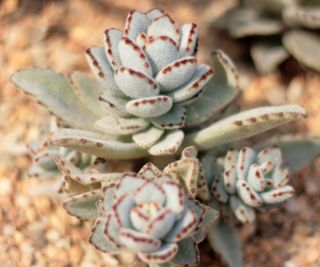
(Image credit: Yippa / Getty Images)
Kalanchoe tomentosa is the panda plant, also known as pussy ears or donkey ears. The animal monikers refer to the plant’s fuzzy, rounded leaves, made possible because of the plant’s covering of fine hairs. ‘Teddy Bear’ and ‘Chocolate Soldier’ are two panda plant cultivars. This plant likes full sun and moderate watering. It may grow to two feet (60cm) in height with a similar spread.
3. Flapjack (Paddle Plant)
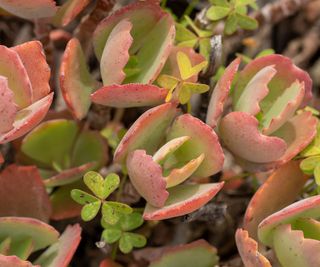
(Image credit: Javier Zayas Photography / Getty Images)
Flapjack (Kalanchoe luciae or Kalanchoe thyrsiflora) is also referred to as the paddle plant. The saucer shaped, thickened leaves layer like a stack of pancakes. Amongst the kalanchoe varieties with colorful foliage, its hues are almost lime green, tinged with pink and covered with a waxy coating that protects the plant from sunburn. When growing paddle plants, you’ll find that it forms a rosette of upright leaves and prefers full sun and well drained soil.
4. Mother of Thousands
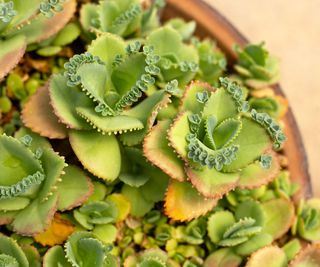
(Image credit: Bowonpat Sakaew / Getty Images)
The colorfully named mother of thousands is in reference to the plant’s numerous plantlets located along the edges of the leaves. These detach and will form new plants. It is also known as the alligator plant, devil’s backbone and Mexican hat plant. Kalanchoe laetivirens have an upright growth habit and may reach three feet (90cm). Pinkish gray, small, tubular flowers form on long stems.
5. Desert Surprise
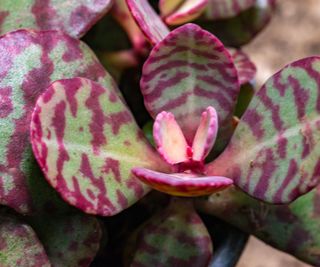
(Image credit: Oleg Kovtun / Getty Images)
Kalanchoe humilis is indeed a surprise. Thick, saucer shaped blue-green leaves with soft notches characterizes this plant. Desert surprise leaves bear irregular splashes of maroon. The leaves grow upright and gently cup towards each other. This is one of the hardy kalanchoe varieties, able to withstand brief exposure to 28 degrees Fahrenheit (-2°C.). Full sun will bring out the best colors in the foliage.
6. Kalanchoe ‘Tarantula’
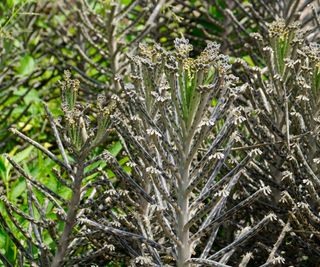
(Image credit: Albin Raj / Getty Images)
Kalanchoe ‘Tarantula’ (Kalanchoe katapifa) is so called due to the foliage’s resemblance to spider legs. It is a bushy plant when mature and grows at a moderate rate up to 10 inches (25cm). It’s fuzzy, with large velvety stems covered in golden hairs, but the good news is that it’s extremely easy to grow. Pictured is the Chandelier kalanchoe, which also has unusual elongated foliage.
7. Marnier’s Kalanchoe
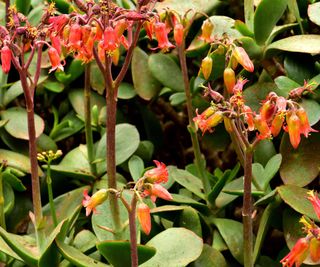
(Image credit: José María Barres / Alamy)
Kalanchoe panamensis produces roots from its leaves that will delve into soil. New shoots emerge from these roots which can be divided away from the parent plant and potted up separately. The leaves are small, rounded, gray-green, and have pink edges. It produces tight bell-like flowers in bright pink. This plant can reach 18 inches (45cm) tall and achieve a span of three feet (90cm).
8. Kalanchoe ‘Fire Rainbow’
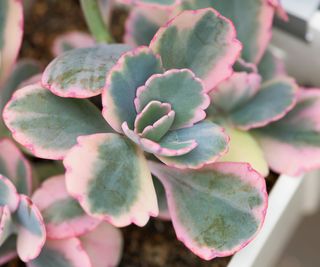
(Image credit: Christina Siow / Shutterstock)
This is a variegated hybrid with magnificent, waxy leaves in hues of ivory, green and bright pink. The leaves of Kalanchoe ‘Fire Rainbow’ are cupped with softly serrated edges. The leaves are erect or drooping and when they touch the ground, they root and produce plantlets. ‘Fire Rainbow’ needs well draining soil and deep but infrequent watering. Pictured is the similarly toned ‘Lavender Scallops’ kalanchoe.
Frequently Asked Questions
What is the most popular Kalanchoe?
Florist Kalanchoe is the one you will see at grocery stores, florist shops and nursery centers. Also known as Flaming Katy, this kalanchoe is distinctive for its compact floral clusters in reds, oranges, yellows, whites or pinks. Kalanchoe blossfeldiana is hardy in USDA zones 10-12 and also thrives as a houseplant.
How do I identify my Kalanchoe?
With over 100 species and each so different, it may be difficult to identify your plant. There are online forums dedicated to the genus that may be able to help. The only commonality among the kalanchoe plant types is that they are spineless. Leaf, growth form, color, flower and propagation methods all vary.




